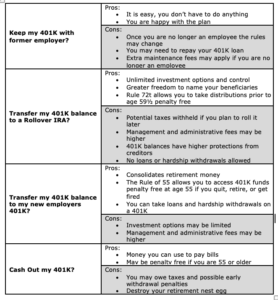To rollover or not rollover…that is the question.
Posted
on Jun 23, 2022
on Jun 23, 2022
If you have changed jobs or perhaps recently retired, chances are you were contributing toward your retirement in a 401K (or 403b) and have built up a balance in your account. What should you do with the balance in your account after you leave your job? Well, that depends on your situation. Here is a chart I have made with the pros and cons of the options available to you.
Depending on which of the options you choose for your 401K balance, here are some additional tips and things to watch out for to make for a smoother transfer.
-
- Prior to leaving your job, make sure you have access to your retirement plan account and have the plan administrator’s contact information.
- Verify that the 401K plan offered by your new employer can accept rollovers before you initiate a rollover.
- If you have both Roth 401k and Traditional 401k balances, you will need to keep the balances separate when you do a rollover.
- Don’t wait too long to make your decision, the task becomes more difficult when you must spend time tracking down all the information you need to complete the rollover. You also may lose track of old accounts that are not rolled over.
- Choosing to transfer your balance to a Rollover IRA means you will have to make your own investment selections so you may need to hire a professional to help you.
- Track the progress of the rollover and be sure to invest it when it arrives in your account.
Facing these types of financial decisions can feel overwhelming, resulting in taking no action at all. But doing nothing can be costly and complicate your financial life. You certainly don’t want to pay unnecessary taxes or penalties when it comes to retirement accounts, so remember to consult with your financial advisor or tax professional if you are unsure about how to proceed.



